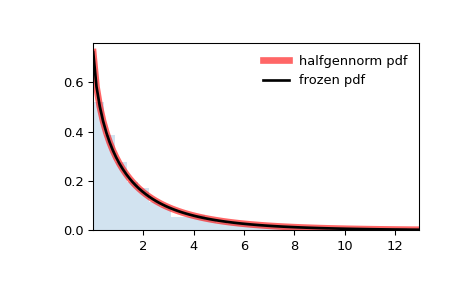scipy.stats.halfgennorm#
- scipy.stats.halfgennorm = <scipy.stats._continuous_distns.halfgennorm_gen object>[source]#
The upper half of a generalized normal continuous random variable.
As an instance of the
rv_continuousclass,halfgennormobject inherits from it a collection of generic methods (see below for the full list), and completes them with details specific for this particular distribution.Methods
rvs(beta, loc=0, scale=1, size=1, random_state=None)
Random variates.
pdf(x, beta, loc=0, scale=1)
Probability density function.
logpdf(x, beta, loc=0, scale=1)
Log of the probability density function.
cdf(x, beta, loc=0, scale=1)
Cumulative distribution function.
logcdf(x, beta, loc=0, scale=1)
Log of the cumulative distribution function.
sf(x, beta, loc=0, scale=1)
Survival function (also defined as
1 - cdf, but sf is sometimes more accurate).logsf(x, beta, loc=0, scale=1)
Log of the survival function.
ppf(q, beta, loc=0, scale=1)
Percent point function (inverse of
cdf— percentiles).isf(q, beta, loc=0, scale=1)
Inverse survival function (inverse of
sf).moment(order, beta, loc=0, scale=1)
Non-central moment of the specified order.
stats(beta, loc=0, scale=1, moments=’mv’)
Mean(‘m’), variance(‘v’), skew(‘s’), and/or kurtosis(‘k’).
entropy(beta, loc=0, scale=1)
(Differential) entropy of the RV.
fit(data)
Parameter estimates for generic data. See scipy.stats.rv_continuous.fit for detailed documentation of the keyword arguments.
expect(func, args=(beta,), loc=0, scale=1, lb=None, ub=None, conditional=False, **kwds)
Expected value of a function (of one argument) with respect to the distribution.
median(beta, loc=0, scale=1)
Median of the distribution.
mean(beta, loc=0, scale=1)
Mean of the distribution.
var(beta, loc=0, scale=1)
Variance of the distribution.
std(beta, loc=0, scale=1)
Standard deviation of the distribution.
interval(confidence, beta, loc=0, scale=1)
Confidence interval with equal areas around the median.
See also
Notes
The probability density function for
halfgennormis:\[f(x, \beta) = \frac{\beta}{\Gamma(1/\beta)} \exp(-|x|^\beta)\]for \(x, \beta > 0\). \(\Gamma\) is the gamma function (
scipy.special.gamma).halfgennormtakesbetaas a shape parameter for \(\beta\). For \(\beta = 1\), it is identical to an exponential distribution. For \(\beta = 2\), it is identical to a half normal distribution (withscale=1/sqrt(2)).References
[1]“Generalized normal distribution, Version 1”, https://en.wikipedia.org/wiki/Generalized_normal_distribution#Version_1
Examples
>>> import numpy as np >>> from scipy.stats import halfgennorm >>> import matplotlib.pyplot as plt >>> fig, ax = plt.subplots(1, 1)
Get the support:
>>> beta = 0.675 >>> lb, ub = halfgennorm.support(beta)
Calculate the first four moments:
>>> mean, var, skew, kurt = halfgennorm.stats(beta, moments='mvsk')
Display the probability density function (
pdf):>>> x = np.linspace(halfgennorm.ppf(0.01, beta), ... halfgennorm.ppf(0.99, beta), 100) >>> ax.plot(x, halfgennorm.pdf(x, beta), ... 'r-', lw=5, alpha=0.6, label='halfgennorm pdf')
Alternatively, the distribution object can be called (as a function) to fix the shape, location and scale parameters. This returns a “frozen” RV object holding the given parameters fixed.
Freeze the distribution and display the frozen
pdf:>>> rv = halfgennorm(beta) >>> ax.plot(x, rv.pdf(x), 'k-', lw=2, label='frozen pdf')
Check accuracy of
cdfandppf:>>> vals = halfgennorm.ppf([0.001, 0.5, 0.999], beta) >>> np.allclose([0.001, 0.5, 0.999], halfgennorm.cdf(vals, beta)) True
Generate random numbers:
>>> r = halfgennorm.rvs(beta, size=1000)
And compare the histogram:
>>> ax.hist(r, density=True, bins='auto', histtype='stepfilled', alpha=0.2) >>> ax.set_xlim([x[0], x[-1]]) >>> ax.legend(loc='best', frameon=False) >>> plt.show()
